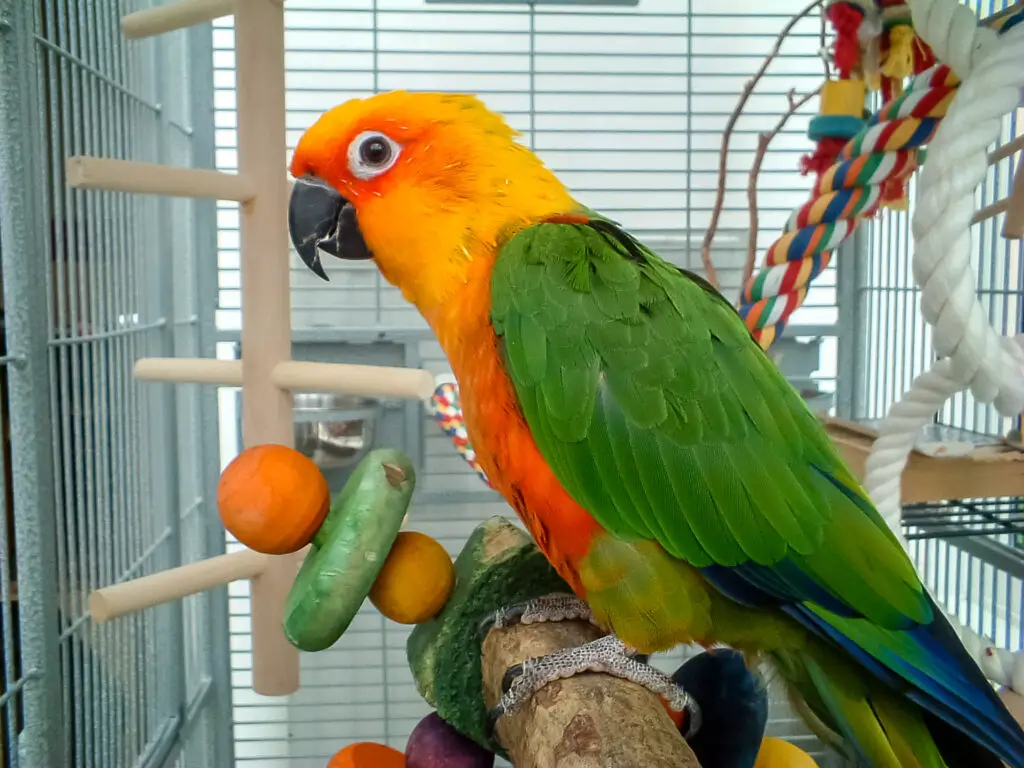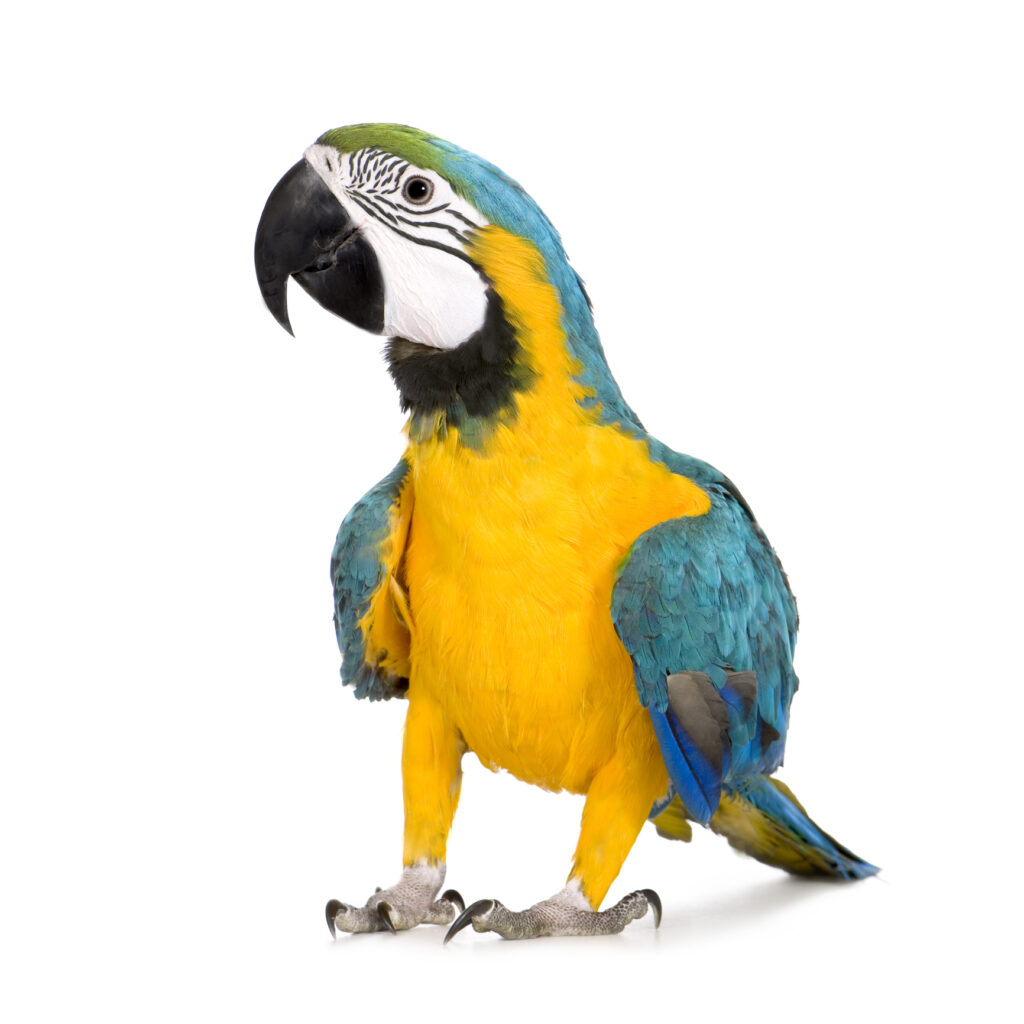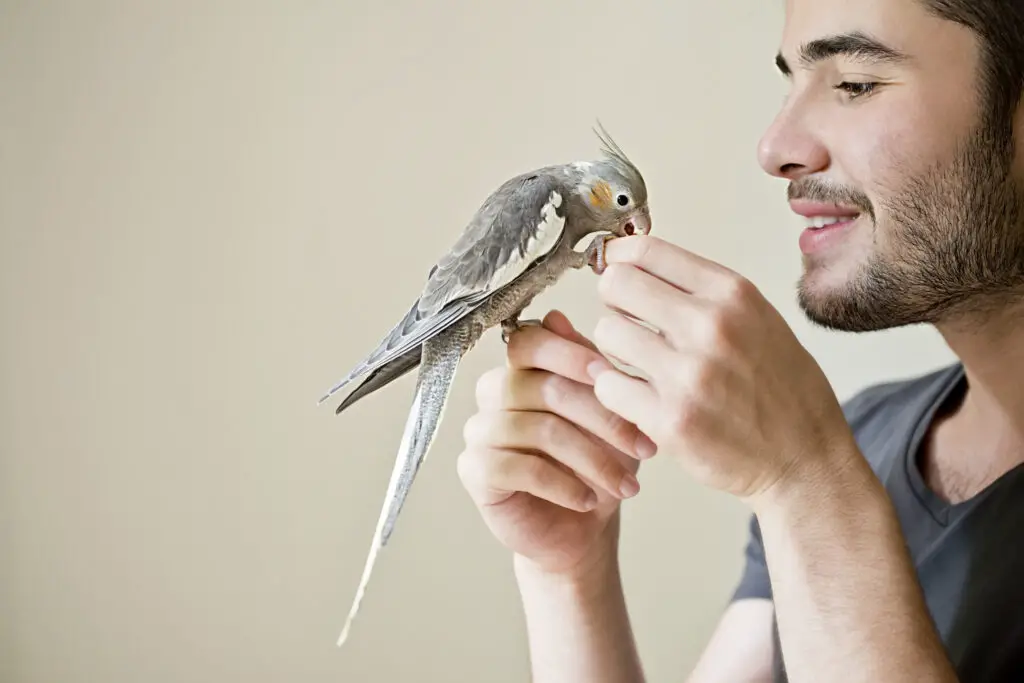Parrot beaks are strong enough to support their entire body when they hang upside down. For instance, macaws, the largest of all parrots, have beaks so strong that their bite can reach 1,500 pounds per square inch (psi). The beak is also this bird’s primary tool for almost anything it does.
But for your parrot to use its beak well, it has to be in tip-top condition. For this reason, knowing what is wrong with your pet’s beak and how to take care of it is crucial.
Key Takeaways
This article will discuss the following:
- Why are parrot beaks curved
- The anatomy of a parrot’s bill
- Common conditions you need to observe on your pet’s beak
- Caring for a parrot’s beak
The beaks of parrots are curved to accommodate their diet. Parrots use the curve of their beaks to crack hard seeds and scoop out fruit flesh. These birds also use their beaks to carve out nests on tree trunks.
An abnormality in your parrot’s beak can affect its overall health. So, in this article, we will discuss common beak conditions and how to take care of your pet’s beak to keep them healthy.
Everything You Need To Know About Parrot Beaks

Have you ever wondered why parrot beaks are curved? Aviculturists call these birds hookbills due to the shape of their beaks. All species of parrots have curved beaks, which make them easy to distinguish from other birds.
It is easy to assume that parrots only use their beaks for eating. But in reality, the beak of these birds has several essential functions. In fact, bird enthusiasts refer to a parrot’s bill as its third hand (a.k.a feet.)
Why Are Parrots Beaks Curved?
The beak of a parrot is a crucial part of its daily life. It uses it for eating, preening, gripping something, and making nests. The beak is also the parrot’s line of defense against predators.
Parrots have curved beaks to accommodate their diet. Not only can these birds eat the flesh of fruit but also its seeds. But since the outer layer of a seed can be tough to chew, parrots use the curved portion of their upper beak to extract the edible part of the seed.
The curved shape of a parrot’s bill is also beneficial as it can make splitting hard-shelled fruits and seeds easier.
Moreover, a parrot’s upper beak can move upward independently. According to Mecial Center For Birds, parrots have a unique synovial joint called the craniofacial hinge on their beak. This flexible joint allows the birds to move their upper beaks alone during certain circumstances.
For instance, when a parrot is digging the bark of a tree to make a nest, it can move its upper beak to scoop out the wood and chew it.
Anatomy Of A Parrot’s Bill
The outer layer of a parrot’s bill consists of keratin. Under this layer, there are bony jaws divided into two parts:
- upper maxilla
- lower mandible
A beak’s keratin covers a network of blood vessels and nerve endings. These nerves provide the parrot’s bill, especially the tip, with fantastic sensory ability. A parrot can use its beak to sense an environment’s temperature. This bird can also control the amount of pressure it exerts on its bite using the sensory nerves on the beak.
According to an article written in the New Zealand Journal Of Zoology, the upper portion of a parrot’s bill is the rhinotheca. At the same time, the mandibular part is called the gnathotheca. This bird’s nostrils are at the top of the maxillary beak, particularly on the cere. The cere is a soft, fleshy, thick portion of the upper beak.
While no one knows the actual purpose of a bird’s cere, anatomist and veterinarian Dr. Boniface M. Kavoi claims that it is an adaption to its diet. The cere covers the band of parrot beaks, thus extending to the corners of the mouth called the commissure.
Furthermore, the tomium is the edge of a parrot’s bill, which it uses for gripping and cutting food.
Signs Of A Health Beak

A healthy beak will allow your parrot to enjoy its basic functions without pain or difficulty. Keep your parrot healthy, and its beak will remain healthy as well. Considering that your pet does not have any health condition, its beak will show signs of good health.
Smooth Appearance
Healthy parrot beaks should appear smooth and shiny. However, some species of parrots may have a healthy yet dull beak. For instance, cockatoos produce a powdery coating on their feathers called dander. When cockatoos are preening, this dander coats their beaks, thus making them look dull.
But the beak should have a shiny coating in parrot species that do not produce a powdery feather coating. There should also be no flaking, unusual texture, or crustiness on the beak’s edge and surface.
Symmetrical Alignment
Parrot beaks should align symmetrically if they are healthy. The maxillary and mandibular beaks should fit together when the parrot closes its mouth. In addition, there should only be a slight downward curve on the parrot’s upper beak.
In addition, the curve of the maxillary beak should not hinder a parrot from opening its mouth. When checking your bird’s beak, the commissure should be smooth, without any abnormal groove.
Consistent Coloration
As only keratin makes up the external coating of parrot beaks, they should have a consistent coloration. The ceres of some parrots have a different color from the beak. While this fact is entirely normal, the cere should not have any unusual discoloration.
Proper Length
A parrot’s bill should stay at a length that is comfortable for it. A healthy parrot will trim its beak naturally in the wild by pecking on wood and tough seeds. In captivity, your feathered companion should trim its beak using chew toys and wooden perches as if imitating its instinct in the wild.
The repetitive chewing action when your parrot is eating can also wear its beak down and prevent it from overgrowing.
Common Parrot Beak Health Conditions
While proper nutrition is the key to keeping parrot beaks healthy, some health conditions can affect them. These health conditions may even significantly impact your parrot’s overall wellness.
Beak Trauma
Domesticated parrots tend to bite their cage’s bar. Sometimes, the beak can get stuck in the middle of cage bars, thus resulting in trauma and injury. A parrot’s bill may also acquire fracture when you let it out of its cage, and it accidentally flies and bumps into a glass window.
These injuries can fracture the beak’s bone or leave an open wound on the keratin layer. In these cases, your pet’s beak can be partially or entirely torn off its face. As mentioned, a parrot’s beak consists of blood vessels and nerve endings, so injuries are painful for your feathered friend regardless of how minor or severe they are.
If your parrot got its beak injured, it requires medical attention even if the injury is not severe. Failing to have your pet’s beak treated can result in infection, thus making it more severe.
Infection
Apart from untreated injuries, parrot beaks can also get infectious diseases from the bird’s surroundings or the food they eat. The reason is that parrots use their beak for almost anything. For instance, if your pet parrot accidentally ate something filled with bacteria, parasites, or fungi, it will pass through its beak, thus infecting it along with its entire body.
According to the Archives Of Virology, the most common beak infection your parrot can get is the Psittacine Beak And Feather Disease (PBFD). This viral infection suppresses your parrot’s immune system and causes abnormalities in their beaks and feathers. It has no cure and is potentially deadly.
As mentioned, parrots can get an infection from food or an unkempt environment. So, PBFD can spread through food sharing, dried excrement, or interaction with an already-infected bird.
Fortunately, not all parrot bill infections are deadly. Some are treatable with antifungal medications and antibiotics. So, once you notice something unusual on your pet’s beak, it is crucial to have it chicken by a vet as soon as possible.
Abnormalities
Observing parrot beaks while the bird is still young is crucial. There is always a chance that your pet can develop a beak abnormality, which you should take care of early on. Beak abnormalities include:
- Scissor beak – the lateral deviation of the maxillary beak causes this abnormality. In parrots with scissor beaks, the upper beak curved downward too much, causing it to cross over the mandibular beak. In young parrots, genetics and improper incubation may cause scissor beaks. Calcium deficiency, bacterial and viral infection, and physical trauma may cause the same condition in adult parrots.
- Overgrown beak – parrot beaks grow continuously even if they reach adulthood. However, domesticated parrots without enough chew toys cannot trim their beaks on their own, which causes overgrowth. An overgrown beak is uncomfortable for your parrot and may cause various health issues.
- Mandibular prognathism – this condition causes the parrot’s rhinotheca to rest on the sides of the gnatotheca instead of its top. Improper incubation and hand-feeding techniques may cause this condition.
Cancer
The first symptoms of parrot beak cancer are:
- discoloration
- beak erosion
- discoloration
Melanoma and cell carcinoma are the most common beak cancers in parrots. If caught early, avian veterinarians can operate on your pet’s beak to remove its tumor.
How To Take Care Of A Parrot’s Beak

If you have a pet parrot, learning essential information about parrot beaks is crucial in knowing how to take care of them.
Ensure Proper Diet
One of the best ways to keep your pet’s beak healthy is to keep it on a healthy diet. Malnutrition, too much fat, and poor diet can cause your parrot’s beal to become scally, dry, overgrown, and rubbery. For this reason, it is crucial to feed your parrot with nutritious pellets, fruits, vegetables, and seeds.
Visit A Veterinarian Regulary
Keeping your parrot’s bill healthy means regularly checking it by a veterinarian. The avian expert will examine your feathered companion’s beak to ensure it is in good condition and free of diseases and infection. If the vet notices that your parrot’s beak is overgrown, it will also file or clip it to a comfortable length for your pet.
The parrot’s vet may also prescribe medications or vitamins to support the beak’s health and address its concerns.
Provide Chew Toys
One of the best ways to prevent parrot beaks from overgrowing at home is to give your pet entertaining chew toys. For instance, you can get wooden blocks, ropes, and coconut pieces and allow your parrot to bite them. But as your feathered companion’s beak is so strong, prepare to replace destroyed chew toys occasionally.
If your pet does not like to use its toys, you can put some treats on them to make them more enticing.
Maintain A Safe Environment
A parrot’s enclosure should not contain anything that will cause hazards to your pet. You need to check for regularly broken cage bars, which can wound your parrot’s beak if it tries to chew it. In addition, the enclosure should always be clean to keep it free from viruses, bacteria, and parasites that may infect your pet’s beak.
Final Thoughts
Parrot beaks are one of their primary tools for survival, so keeping them in perfect condition is crucial. You can keep your pet’s beak healthy by ensuring a healthy diet. Since a parrot’s bill is prone to various health conditions, regular vet visits are also crucial.
.
Parrots have curved beaks due to their diet. These birds’ beaks are so strong that they can use them to open fruits, make nests on tree trunks, and open hard nuts and seeds.
These Articles May Also Interest You:
- Do Parakeets Bites Hurt? (We’ve Got The Answer)
- How Bad Is A Macaw Bite? (What You Need To Know)
- 7 Reasons Why Conures Bite
- Marianne Taylor. How Birds Work: An Illustrated Guide to the Wonders of Form and Function—from Bones to Beak. Hachette UK, 2020. https://books.google.com.ph/books?id=qWh4EAAAQBAJ&pg=PT64&dq=parrot+bite+psi&hl=en&sa=X&ved=2ahUKEwjg8d2tgpn9AhVxrVYBHcMuD6gQ6AF6BAgDEAI#v=onepage&q=parrot%20bite%20psi&f=false. Accessed February 15, 2023.
- Echols, Scott, and C. A. Oakley. “Beak Deformities: Form, Function and Treatment Methods.” https://www.alvefas.org/wp-content/uploads/2016/12/Avian-Beak-Deformities-Form_-Function-and-Treatment-Methods.pdf. Accessed February 15, 2023.
- Froggatt, J. M. A., and B. J. Gill. “Bill morphology reflects adaptation to a fibrous diet in the kākāpō (Strigops: Psittaciformes).” New Zealand journal of zoology 43, no. 2 (2016). DOI: https://doi.org/10.1080/03014223.2015.1112820. Accessed February 15, 2023.
- Kavoi, Boniface M. “Functional Comparative Anatomy & Physiology Of Birds Of Prey And Domestic Chicken.” (2013). http://erepository.uonbi.ac.ke/bitstream/handle/11295/72725/Functional%20Comparative%20Anatomy%20&%20Physiology%20Of.pdf?sequence=1. Accessed February 15, 2023.
- Fogell, Deborah J., Rowan O. Martin, and Jim J. Groombridge. “Beak and feather disease virus in wild and captive parrots: an analysis of geographic and taxonomic distribution and methodological trends.” Archives of virology 161 (2016). DOI: 10.1007/s00705-016-2871-2. Accessed February 15, 2023.




